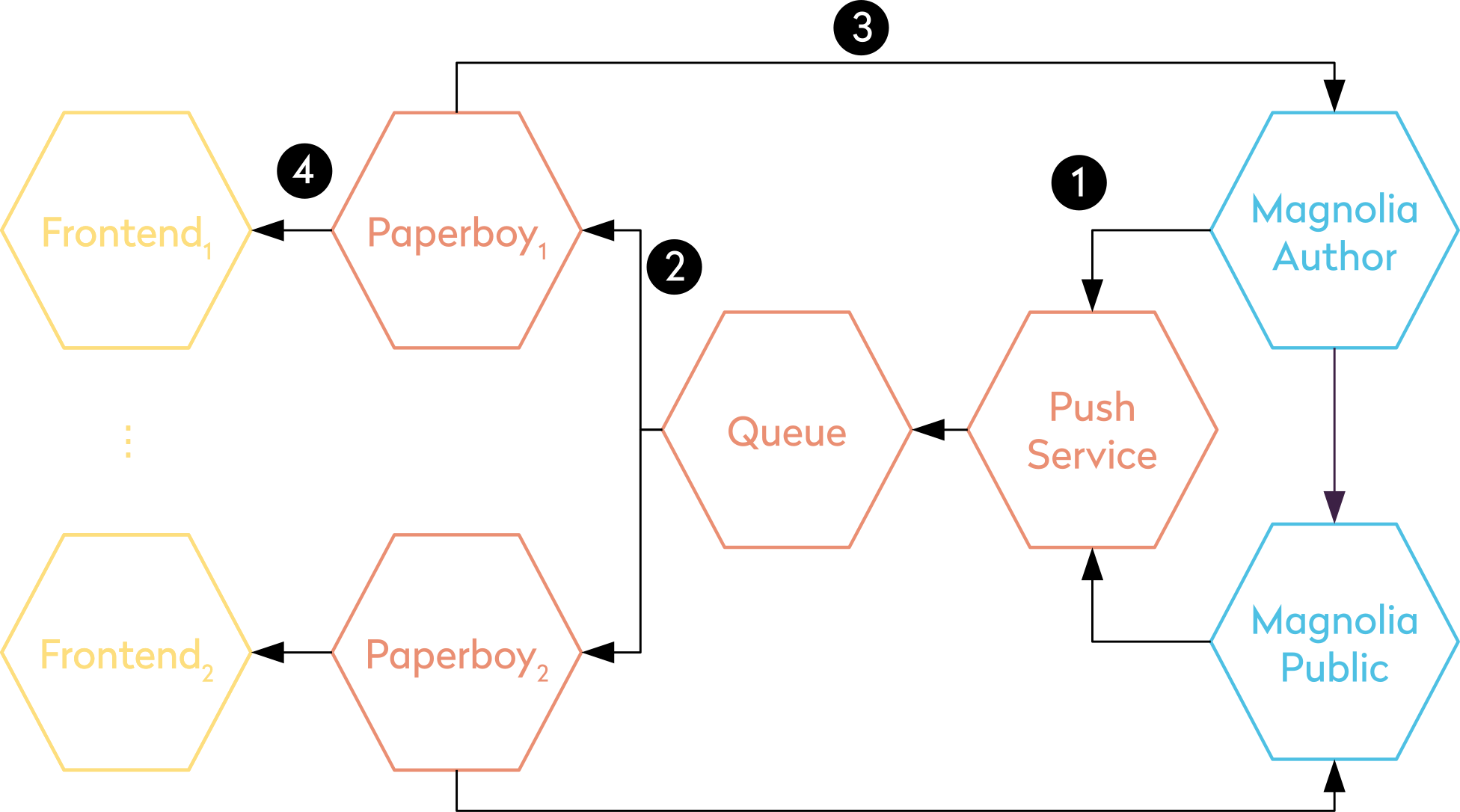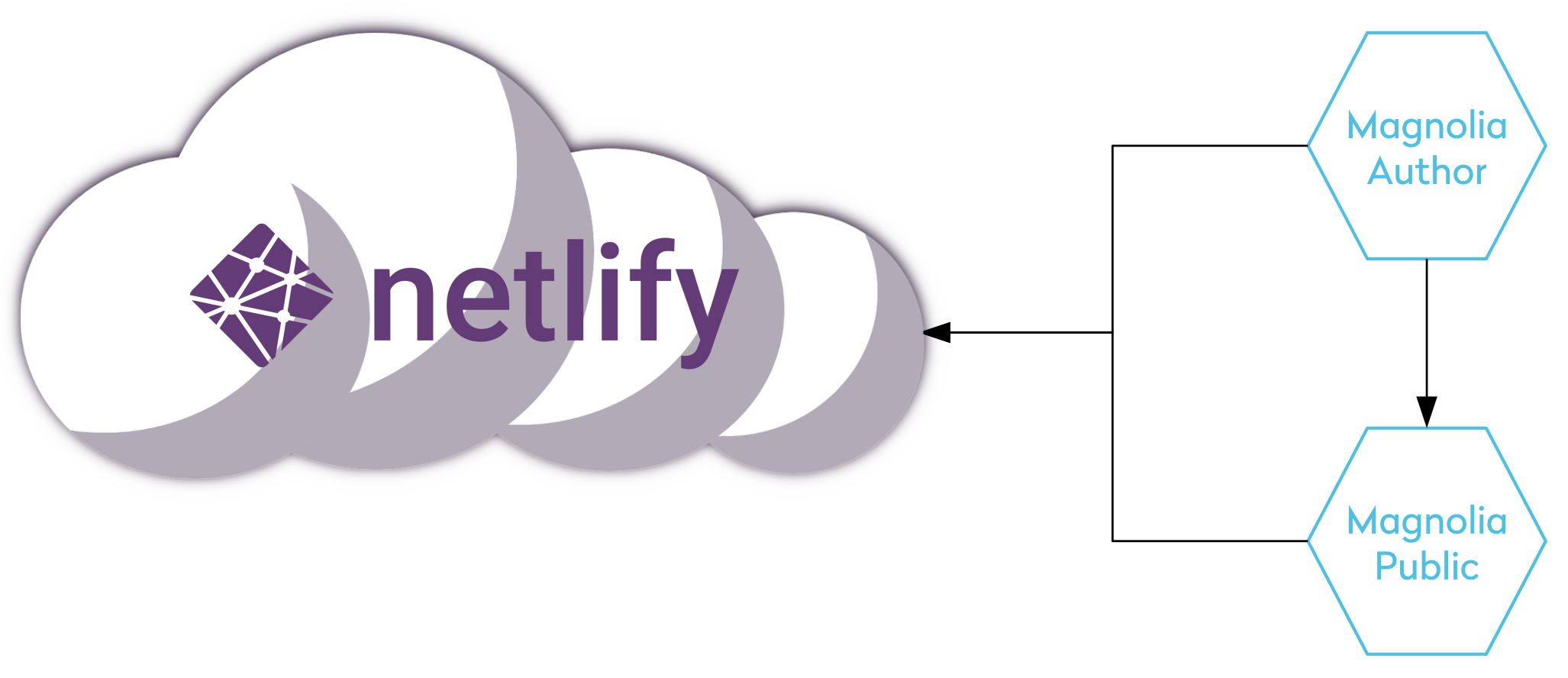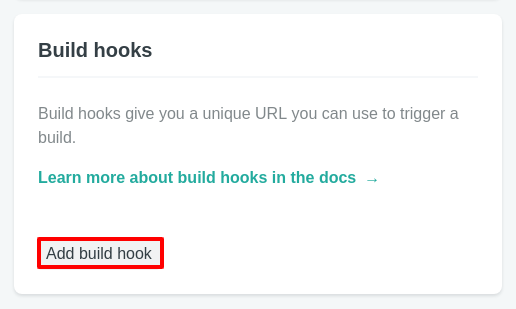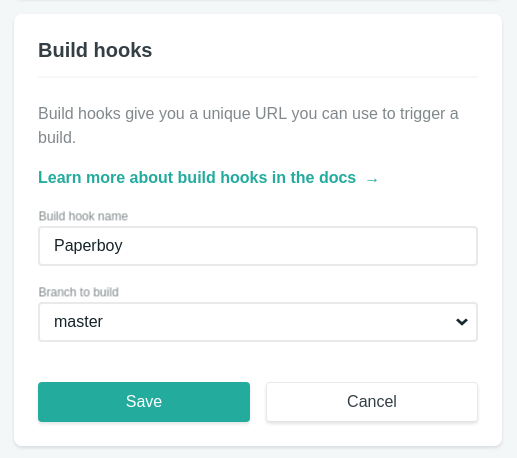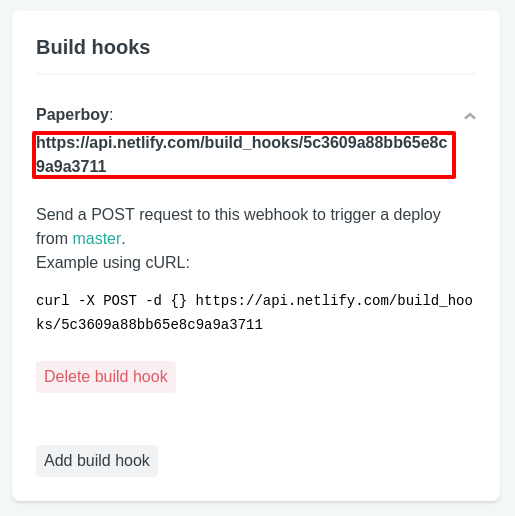A middleware written in TypeScript to connect different CMS with your delivery layer and to notify it of content changes.
To leverage the flexibility of a content management system while having the performance of a static site one needs to decouple the delivery layer from the CMS. Paperboy acts as a broker between these two layers by informing the delivery layer of content changes. To support the use-case of multiple frontend servers Paperboy multiplexes events via a Queue. Using the Magnolia CMS, the complete setup looks like the following:
- This setup works by add a Magnolia module to both instances, which listens for content changes and publishes details of those changes to a Webhook which publishes a message in an AMQP compatible queue
- A client-side library then subscribes to this queue
- When a message is received, the library fetches the content via the delivery endpoint released with Magnolia 5.6, transforms the JSON data (e.g. to ease the use of assets)
- Finally it will execute an arbitrary command to trigger the actual rebuild of the frontend
In case we don't want to operate the delivery tier ourselves and instead use a CDN like Netlify you can use the Magnolia Module to publish directly to a webhook by the CDN provider:
For the content management tier we provide two submodules which together with a queue handle the propagation of content change events:
- Paperboy push service: A small HTTP service that can be used as a webhook.
- Paperboy Magnolia module: A module that integrates directly into Magnolia and sends HTTP messages to the push service whenever a change in a watched workspace occurs.
The subscriber part of this system is currently comprised of three submodules in this repository:
- Paperboy Core: The core library which handles all generic configuration and knows how to execute the commands to trigger rebuilds.
- Paperboy CLI: A simple CLI to ease usage and setup
- Paperboy Magnolia Source: A plug-in for the core which can fetch and transpose JSON data obtained from Magnolia.
To quick start your project set-up, execute the stepts in Frontend Set-Up and Magnolia Set-Up. Afterward eitehr execute the steps from Custom delivery layer or Netlify depending on your setup.
To use Paperboy in your Frontend you can simply install the CLI globally via:
$ npm i -g @neoskop/paperboy-cliIn case that you are writing the frontend with JavaScript you can also install the CLI locally in your project:
$ npm i --save-dev @neoskop/paperboy-cli
Generate a blank Magnolia project using Magnolia's archetype catalog:
$ mvn org.apache.maven.plugins:maven-archetype-plugin:2.4:generate -DarchetypeCatalog=https://nexus.magnolia-cms.com/content/groups/public/ \
-Dfilter=info.magnolia.maven.archetypes:magnolia-project-archetypeAfterwards add the Paperboy Magnolia Module to the webapp's POM.xml:
<dependency>
<groupId>de.neoskop.magnolia</groupId>
<artifactId>paperboy</artifactId>
<version>1.0.0</version>
</dependency>Build the WAR and deploy it in a servlet container.
In case of a custom deliver layer, start the push service and a RabbitMQ server by running the following command in the root folder of this repository:
$ docker-compose upWhen the containers are up and running, import the following config into Magnolia's configuration under /modules/paperboy/config:
webhookConfig:
authorization: BEARER_TOKEN
bearerToken: eash9uk3eejak6ena7thi8DooMih5eax
url: http://push-service:8080/To configure the frontend, create a file called paperboy.config.json with the following contents:
{
"sourceOptions": {
"name": "magnolia",
"output": {
"json": "src",
"assets": "src/assets",
"excludedProperties": [
"jcr:created",
"jcr:createdBy",
"jcr:lastModifiedBy",
"jcr:lastActivated",
"jcr:lastActivatedBy",
"jcr:activationStatus",
"jcr:lastActivatedVersion",
"jcr:lastActivatedVersionCreated",
"jcr:primaryType",
"mgnl:created",
"mgnl:createdBy",
"mgnl:lastModifiedBy",
"mgnl:lastActivated",
"mgnl:lastActivatedBy",
"mgnl:activationStatus",
"mgnl:lastActivatedVersion",
"mgnl:lastActivatedVersionCreated",
"mgnl:primaryType"
]
},
"magnolia": {
"url": "http://localhost:8080",
"damJsonEndpoint": "/.rest/delivery/dam/v1",
"pagesEndpoint": "/.rest/delivery/website/v1",
"sitemapEndpoint": "/sitemap",
"auth": {
"header": "Basic cGFwZXJib3k6d0xGYkxqTkN4QVg4dzR0RVFHdzQyRDZP"
}
},
"queue": {
"uri": "amqp://admin:Boo4bah3ohcohthaeHa5ohter0iSeeS0@localhost:5672",
"exchangeName": "paperboy_preview"
}
},
"sinkOptions": {
"async": true,
"command": "npm start",
"restartOnChange": false,
"workDir": "."
}
}Finally change to the frontend directory and run:
$ paperboy startTo configure the frontend, create a fiel called paperboy.config.json with the following contents:
{
"sourceOptions": {
"name": "magnolia",
"output": {
"json": "src",
"assets": "src/assets",
"excludedProperties": [
"jcr:created",
"jcr:createdBy",
"jcr:lastModifiedBy",
"jcr:lastActivated",
"jcr:lastActivatedBy",
"jcr:activationStatus",
"jcr:lastActivatedVersion",
"jcr:lastActivatedVersionCreated",
"jcr:primaryType",
"mgnl:created",
"mgnl:createdBy",
"mgnl:lastModifiedBy",
"mgnl:lastActivated",
"mgnl:lastActivatedBy",
"mgnl:activationStatus",
"mgnl:lastActivatedVersion",
"mgnl:lastActivatedVersionCreated",
"mgnl:primaryType"
]
},
"magnolia": {
"url": "http://localhost:8080",
"damJsonEndpoint": "/.rest/delivery/dam/v1",
"pagesEndpoint": "/.rest/delivery/website/v1",
"sitemapEndpoint": "/sitemap",
"auth": {
"header": "Basic cGFwZXJib3k6d0xGYkxqTkN4QVg4dzR0RVFHdzQyRDZP"
}
}
},
"sinkOptions": {
"async": false,
"command": "npm run build",
"restartOnChange": false,
"workDir": "."
}
}To configure the netlify build create a file called netlify.toml with the following contents:
[Settings]
ID = "paperboy-netlify-demo"
[build]
base = "/"
publish = "dist/"
[context.develop]
command = "paperboy build"
[context.master]
command = "paperboy build"This setup alone will only fetch the content from Magnolia whenever a change in the repository triggers a rebuild of the site on Netlify.
To also trigger a rebuild of the frontend whenever a change in Magnolia's content occurs, create a webhook in Netlify under Settings > Build & Deploy in your project.
Click "Add build hook":
Give the hook a meaningful name and press "Save":
Copy the webhook's URL:
Finally import the following config into Magnolia's configuration under /modules/paperboy/config:
webhookConfig:
authorization: NONE
url: https://api.netlify.com/build_hooks/<webhook-id>This project is under the terms of the Apache License, Version 2.0. A copy of this license is included with the sources.

